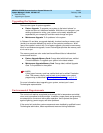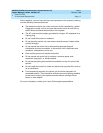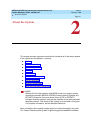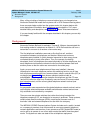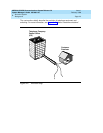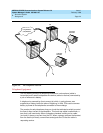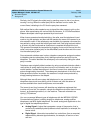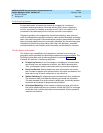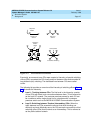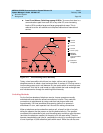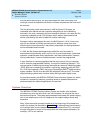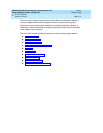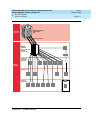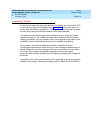
MERLIN LEGEND Communications System Release 6.0
System Manager’s Guide
555-660-118
Issue 1
February 1998
About the System
Page 2-5Background
2
Similarly, the CO signals the called party by sending current to his or her phone,
causing it to ring. When the called party lifts the handset from its cradle, the
current flows, indicating to the CO that the party has answered.
Bell realized that a caller needed a way to signal the other person to pick up the
phone. After experiments with various bells and buzzers, in 1878 Bell’s assistant
Watson developed a bell ringer operated by a hand crank.
When human operators handled switching, the caller used the telephone’s hand
crank to ring the operator, and then told the operator the name of the person he or
she wanted to reach. If the called party was available, the operator connected the
two parties by using a cord that had plugs at each end. Each plug had parts called
a
tip and a ring
that functioned as conductors to complete the electrical circuit.
The operator connected the two parties by plugging in one end of the cord into the
caller’s connector (called a
jack
) on the switchboard, and the other end of the cord
into the called party’s jack.
Once automatic switches were in place, telephone companies assigned numbers
to telephone service subscribers, and a dialing mechanism was built into the
telephone. The caller identified the called party to the switch by dialing the called
party’s number.
Telephone users originally dialed numbers by using a mechanical device called a
rotary dialer
. A spring wound up when turned in one direction and, on its return to
normal position, caused interruptions in the flow of current, thus creating dial
pulses recognized by the switch. The subsequent development of the touch-tone
dialer provided a further innovation: the creation of unique tones produced by
simply pressing buttons on the dialpad.
Although there are still some rotary-dial telephones in use, most modern
telephones have touch-tone dialing, which is faster and, with the advent of
services available from touch-tone phones, more versatile.
The terms
tip
and
ring
, however, still describe any telephone equipment that
involves only one line, for example, a single-line telephone (such as those in most
homes), an answering machine, or a fax machine. These are referred to as
tip/ring
(
T/R
) devices.
You can use several different types of telephones with the MERLIN LEGEND
Communications System, including single-line telephones, analog multiline
telephones, and MLX digital telephones. The terms
analog
and
digital
refer to the
type of signal the telephone produces:
■ Analog Signal. A signal that represents a range of frequencies, that is,
continuously variable physical qualities such as amplitude; for example, the
human voice.
■ Digital Signal. Information transmitted in a coded form (from a computer)
represented by discrete signal elements; for example, off and on or zero
and one.




